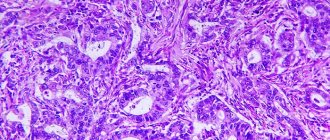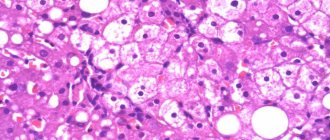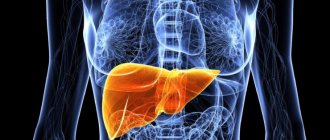A healthy person rarely thinks about illness. However, a failure can occur in any body, which will be accompanied by disturbances in life support systems. This possibility cannot be completely excluded. If at a doctor’s appointment a word such as “malignancy” was heard (we’ll tell you what this means a little later), then a person far from medicine is unlikely to understand what we are talking about. Is this life-threatening? What causes the complication? What symptoms accompany the process of malignancy and how is it diagnosed? It is these questions that can be answered in this article.
Malignancy – what is it?
A healthy human body works like a clock. It constantly generates and develops cells that participate in important processes. However, when there are deviations, pathological changes in structure occur in them. This results in the appearance of tissue material. This phenomenon in medicine is called malignancy. During its development, a change in the genetic program occurs. Cell reproduction by division leads to rapid tissue growth.
This process is progressive. When it is activated, tumors of a benign or malignant nature are formed in the body. At the initial stage, it is quite difficult to diagnose cell malignancy. This period is asymptomatic. The patient does not feel pain or discomfort, so he is not even aware of the development of the disease.
If the body has already started the process of degeneration of malignant cells, then it is not possible to stop it or regulate it in any way. Doctors consider it irreversible. Unfortunately, in this case, new foci (metastases) appear very quickly, affecting different organs. It is their rapid growth that most often leads to death.
Cell malignancy can be caused by various factors, both internal and external. This phenomenon may also have genetic causes. When diagnosed in the early stages and stopping the rapid proliferation of cells, you can count on a favorable prognosis.
How to recognize malignancy
Having carried out dynamic monitoring of patients with malignant ulcerative process, doctors recommend that they take into account that properly administered conservative therapy usually leads to healing of the ulcer within 4 weeks. The patient's condition improves significantly. In laboratory diagnostics, cytological analysis of lavage water obtained during gastric lavage plays an important role. X-ray examination in the early stages of the process provides practically no useful information.
At the stages of the advanced process, a picture is observed on the radiograph: A large niche appears, with a diameter of more than 2 cm. The niche has a great depth, and there is a wide area of infiltration around it. The mucous membrane around the ulcer acquires an irregular shape, and the muscle wall at the location practically does not contract. X-ray defects in filling with contrast agent are sometimes observed in one of the niche areas.
During malignancy, the ulcerative shaft becomes symmetrical and wider. The niche during malignancy differs in appearance from the cancer niche in the stage of decay of the primary process. In order to promptly identify the onset of malignancy, it is necessary to undergo regular examination by a gastroenterologist and perform a gastroscopy procedure with tissue biopsy.
Causes
Having understood the definition of the medical term “malignancy”, what kind of phenomenon it is and what features it has, it is necessary to consider the reasons that cause this process. Unfortunately, scientists around the world are trying to develop a cure to fight cancer. However, the developed methods currently cannot guarantee a 100% result. Why? Most likely, scientists cannot yet identify the exact reasons that provoke deviations in cell development. Several hypotheses have now been presented. It is worth noting that none of them has genuine confirmation. But each one says that malignancy occurs due to the simultaneous impact of several unfavorable factors. Scientists distinguish internal and external causes. The first include the following:
- Inflammatory chronic processes.
- Impaired functioning of the immune system.
- Pathology of the thyroid gland.
- Fungal and viral diseases.
- Nervous disorders, stress.
- Chronic feeling of overwork and fatigue caused by disturbances in the functioning of the autonomic system.
- Hereditary predisposition.
- Unstable mental state.
- Hormonal imbalance.
External causes that can provoke malignancy include:
- Exposure to X-ray equipment (dose several times higher than normal).
- Ecology problems, environmental pollution.
- Abuse of junk food containing large amounts of dyes, carcinogens and other elements.
- Exposure to solar radiation on the body (insolation).
- Poisoning with chemically active substances.
Malignancy
The cause of cell malignancy is a combination of several factors, among which experts indicate chemical carcinogens, environmental features, some viruses, hormonal imbalance conditions, age, bad habits and unfavorable heredity. When conducting research, it was found that malignancy can be provoked by more than 2000 different chemical substances, however, the degree of their influence on the processes of malignant degeneration of cells can vary greatly.
The list of chemical compounds that certainly cause cell malignancy includes polycyclic aromatic hydrocarbons (sources include transport, industrial enterprises and heating systems), nitrosamines (found in cigarettes, some types of beer and amidopyrine), hydrazine derivatives (included in herbicides and some medicinal products). products), asbestos and other mineral fibers (sources from industrial production), as well as some metal compounds.
The most significant physical factor of malignancy is solar radiation, the level of which directly affects the likelihood of developing skin cancer. The lighter the skin and hair and the longer a person is exposed to sunlight, the higher the risk of developing melanoma, basal cell carcinoma and squamous cell skin cancer. In addition, malignancy can be stimulated by ionizing radiation, which provokes the occurrence of leukemia, bone tumors (radioactive strontium) and thyroid cancer (radioactive cesium and iodine).
It has been proven that the likelihood of malignancy increases when cells are exposed to certain viruses, in particular the ATLV virus (causes leukemia), the Epstein-Barr virus (provokes the development of Burkitt's lymphoma), the human papilloma virus (plays a role in the occurrence of cervical cancer) and the herpes virus Type II. Malignancy is also promoted by hormonal imbalances. Hormones can directly provoke malignancy, act indirectly on cells by stimulating their proliferation, have a negative effect on the immune system and change the metabolism of certain carcinogens.
Genetic predisposition plays a significant role in the process of malignancy. Many hereditary diseases with a high probability of malignancy have been described, for example, systemic intestinal polyposis, in which most patients develop colon cancer by the age of 40-50, or Down's disease, in which the risk of developing leukemia is 11 times higher than the population average. There is a connection between malignancy and congenital malformations.
A relationship is revealed between the likelihood of malignancy in the tissues of certain organs and the gender of the patient. Men are 2.4 times more likely to suffer from eye tumors, 2.1 times more likely to suffer from stomach tumors, 2 times more likely to suffer from malignant lesions of the nasopharynx, and 1.7 times more often to suffer from bone tumors. In women, malignancy of thyroid tissue is detected twice as often. The first place in prevalence in men is occupied by tumors of the respiratory tract, in women - tumors of the genital organs and breast. In most cases, the likelihood of malignancy in patients of both sexes increases with age, but some types of neoplasms are more often detected in children or young adults.
Some of the habits that have the greatest impact on cell malignancy include smoking, poor diet and alcohol intake. Smokers are 11 times more likely to develop lung cancer; tumors of the oral cavity, larynx and pharynx – 7 times more often; bladder neoplasms – 2.2 times more often; pancreatic tumors – 1.7 times more often than in non-smokers. The main dietary habits that increase the likelihood of malignancy are the intake of large amounts of meat, fatty, hot and spicy foods, a tendency to over-salt and the consumption of insufficient amounts of plant fiber. Alcohol itself does not cause malignancy, but acts as an activator, enhancing the impact of other factors.
Signs
Most often, the symptoms that accompany this process vary depending on where the pathology is present. However, scientists have identified some common signs of malignancy observed in all types of diseases.
- Changes in cells and the appearance of deviations in their development.
- Formation of metastases.
- Failure of a genetically programmed program, leading to changes in the structure and functionality of the cell.
- Activation of the ability to divide and rapid growth.
- Formation of various cancer cells.
- Pronounced contradictory properties.
Properties of the tumor after malignancy
Malignant neoplasms have a number of properties that are absent in any normal cells and tissues of the body:
- As a result of malignancy, the tumor becomes capable of rapid growth, accompanied by compression or destruction of surrounding tissues.
- When malignancy occurs, the neoplasm develops the ability to infiltrate (invade) into surrounding tissues.
- After malignancy, the tumor has the ability to spread through metastasis. Malignant tumor cells migrate with the blood and lymph flow, and then “settle” in various organs and tissues, giving rise to secondary tumors (metastases). It has been established that there is a certain “tropism” - a tendency to metastasize to certain organs and tissues, depending on the type of primary neoplasm.
- When malignancy occurs, the tumor develops the ability to produce toxins that have a pronounced negative effect on the patient’s body. The development of a malignant neoplasm is accompanied by general intoxication, fatigue, decreased appetite and weight loss, including cachexia.
- After malignancy, the changed cells are beyond the control of the body's immune system.
- Malignancy is associated with a high tendency to mutations, as a result of which cells acquire unusual abilities (the ability to grow uncontrolled, to lack a response to immune influences, to metastasize, etc.).
- Malignancy is characterized by a low level of cell differentiation. The lower the level of cell maturity, the more malignant the tumor, the faster it progresses and metastasizes, and the higher its resistance to chemotherapy and radiotherapy.
- The malignant neoplasm has pronounced cellular and tissue atypia.
- During the process of malignancy, altered cells and tissues acquire the ability to stimulate the growth of blood vessels. The tissue of a malignant tumor is well vascularized and hemorrhages often occur in it.
Diagnostics
So, malignancy – what is it, a death sentence or a call to fight? Many people give up after learning about their diagnosis. And that's wrong. If malignancy is detected in the early stages, the patient’s chances of long-term remission are significantly increased. Of course, no one can guarantee such a result in an advanced form of the disease, so it is recommended to undergo regular examinations with doctors.
In order to recognize the onset of the pathological process, the patient is prescribed a comprehensive examination, which includes:
- Examination by a specialist.
- Questioning the patient about symptoms and health status, collecting other information (history).
- Analysis of biological material (biopsy).
- ECG.
- Examination of the digestive organs (allows you to determine the malignancy of the ulcer, chronic and inflammatory processes).
- Bacteriological research.
- General analysis of urine, blood and feces. The latter is also examined for occult blood.
- If the doctor suspects skin cancer, epiluminescence microscopy is prescribed.
- Radiography.
- Ultrasound.
- Smear.
- Full computer diagnostics. Unfortunately, it is quite expensive, so it is rarely prescribed.
- Hysteroscopy (if pathology of the pelvic organs is suspected).
- Laparoscopy.
Preventive measures
To prevent malignancy, it can be advised to lead a healthy lifestyle and give up bad habits - smoking and drinking alcohol. Monitor your diet, choosing a balanced diet and giving preference to natural products. You should not overuse spices, especially salt and pepper, as well as various herbs. It is advisable to process food by boiling or baking. Fried, fatty and smoked foods should not be overused. The protein content in the daily diet should not exceed 20%.
Proper nutrition is the prevention of malignancy
In addition to proper nutrition, it is important to try to protect the body from the harmful influences of the external environment. It is even possible to move to an area with a favorable environmental situation. It is advisable to avoid stress, overwork, and not to get nervous over trifles. It is also important to maintain a sleep-wake schedule and give the body moderate physical activity. It is also useful to be in the fresh air.
So that the disease does not take you by surprise, it is recommended to undergo regular scheduled medical examinations; if necessary, you can also undergo histological examinations for the presence of oncological markers; this is a simple and quick way to identify a precancerous condition or even a later stage at a time when symptoms have not yet appeared and treatment with favorable forecast is still possible.
In addition, routine medical examinations will help identify the presence of inflammatory processes in the body. Timely treatment of these disorders will also significantly reduce the risk of malignancy and degeneration of cells into malignant ones.
Symptoms
It is impossible to identify common symptoms that raise suspicion of malignancy due to the fact that the pathology can be localized in different areas, affecting various organs, so the diagnostic criteria will vary. Let's look at the symptoms using specific examples.
Papillomas and moles (nevus):
- The formation does not have clear boundaries, blurring and smoothing are observed.
- The base of the mole becomes significantly denser.
- Changing the shade, up to the appearance of new colors.
- The patient developed a feeling of discomfort in the area of the tumor.
- During the process of malignancy, burning and itching are felt.
- Bloody or watery discharge appears.
Stomach ulcer:
- Accompanied by constant pain.
- The patient is rapidly losing weight.
- When lying down, the pain spreads to the back area and becomes more intense.
- Decreased appetite or its complete absence.
- Weakness and fatigue appear.
- Anemia.
- Pain on palpation is non-local.
- Menstrual cycle disorders in women.
- Patients may experience purulent discharge.
Ovarian malignancy:
- The appearance of discomfort in the lower abdomen and lumbar region.
- The pain is aching in nature.
- There is a feeling of fullness.
- There is a frequent urge to empty the bladder.
- Swelling of the legs.
- Constipation or diarrhea.
Thyroid:
- Pain appears in the larynx area.
- Enlargement of the thyroid gland.
- Disruption of the cardiovascular system.
- Sudden increase/decrease in weight.
- Inflammation of the lymph nodes is observed in the cervical region.
- Nervous disorders appear, expressed by constant anxiety.
- Sleep is disturbed.
- High blood pressure.
Diagnosis of early stage malignancy
A number of specialists who studied the symptoms of malignancy of ulcers at an early stage came to the unanimous conclusion that it is necessary, first of all, to observe and control the nature of the course and possible changes in the ulcer. The early stages of malignancy are characterized by the disappearance of periodicity and seasonal dependence of the pain syndrome. The nature of pain during peptic ulcer disease can change.
The pain becomes less pronounced and sharp, becomes unstable, and loses dependence on food intake. There is a decrease in appetite, which is not typical for peptic ulcer disease. The general condition of the patient's body worsens. The patient begins to rapidly lose weight and experience weakness for no apparent reason. A characteristic symptom appears - an aversion to meat dishes. The acidity of gastric juice gradually decreases. The amount of lactic acid in the gastric juice increases. A picture of hypochromic anemia develops; traces of blood are constantly present in stool tests.
Polyps
Malignization of a polyp is a change in epithelial cells, which leads to the fact that a benign neoplasm acquires a malignant form (adenocarcinoma). Any organs that have a mucous membrane are affected. These include:
- oral and nasal cavities;
- uterus;
- bladder;
- anus, etc.
Organs are affected by both single polyps and large conglomerates. In the first case, the probability of malignancy is no more than 7%, in the second it can reach 95%. This is mainly influenced by the location.
Diagnosis of education is carried out in several ways. Sometimes a polyp can be excised from a patient right in the clinic and a histological analysis can be performed. In other cases, with extensive lesions, abdominal surgery is prescribed.
In order to prevent the transformation of a benign tumor into a cancerous tumor, doctors recommend removing polyps endoscopically (polypectomy) at the initial stage.
Causes of malignancy
Experts are inclined to believe that malignancy will in the near future affect more and more of the population, not only the elderly, but also children and young people. Scientists associate this process with certain factors, such as an increase in life expectancy, a deteriorating environment, bad habits that plague the majority of the world's population, a huge amount of chemicals used in food production, household chemicals, etc. These disappointing forecasts force us to pay a huge role in the study of malignancy in order to understand and, if possible, prevent the process.
Stomach ulcer
Malignancy of gastric ulcers is common. According to statistics, in approximately 15% of patients the pathology has the ability to degenerate into a cancerous tumor. Why is this happening? Doctors still cannot give a definite answer. Most likely, the reasons that lead to malignancy are improper (unbalanced) nutrition. The risk increases significantly if the patient neglects fruits and vegetables, or abuses smoked and fried foods. Doctors also do not rule out a hereditary predisposition.
Malignancy of a benign tumor
A benign tumor is not the cells that have undergone malignancy. As a rule, polyps are formations that arise against the background of a bacteriological effect on the body, less often – a toxic one. In this case, there is a clear established factor in the development of pathology. But such formations are susceptible to malignancy. Doctors believe the cause is toxins released by bacteria during their life processes. They can create inextricable connections with parts of a healthy cell, thereby disrupting the functionality of the entire nucleus.
The most dangerous cases are when a cell that has gone through malignancy begins to produce toxins that affect all organ systems of a healthy body.
In most cases, epithelial neoplasms on the body are susceptible to degeneration into a cancer cell. These include warts, papillomas, polyps, and even simple calluses. If a certain part of the body is constantly influenced by a mechanical, toxic or chemical nature, then sooner or later it will mutate. Its functionality will be disrupted, the original planned genome will be distorted.
A person begins to feel pain and other symptoms only when a cancerous tumor grows or begins to physically put pressure on nerve endings (or compresses blood vessels, after which the natural process of nourishing soft tissues is disrupted, which provokes inflammation). And this happens at stages 2-3 of cancer, when drug treatment does not bring the desired result.
Clinical picture
Malignancy of the stomach has the following clinical picture:
- Decreased activity.
- Refusal of meat food.
- Decreased appetite.
- The intensity of pain in the upper abdomen increases significantly.
- The body stops responding to antispasmodics.
- A persistent feeling of nausea, often accompanied by vomiting.
- During belching, an unpleasant odor appears.
- The skin turns pale.
- There is severe exhaustion.
- There is a feeling of heaviness in the stomach.
- The occurrence of pain no longer depends on food intake.
Symptoms
Symptoms of malignancy, which, first of all, indicate the beginning of the process of tissue degeneration, are associated with a change in the nature of pain. The pain syndrome takes on a vague, aching character.
Moreover, such a symptom of malignancy is constantly present. In addition, pain from a stomach ulcer worsens at night during the period of relaxation of the body. Against this background, the patient experiences a general deterioration in health.
A malignant gastric ulcer also manifests itself in the process of development with other signs:
- Deterioration of appetite, which leads to weight loss and deterioration of the skin.
- Changes in taste preferences, in particular, aversion to meat dishes are often observed.
- Digestive disorder. Constipation and diarrhea often occur, and after eating, belching appears with an unpleasant taste and smell.
- Nausea after eating. Vomiting may occur periodically, which does not bring relief.
Adenoma
Malignancy of adenoma poses a great danger to human life. A tumor can develop in different organs. The probability of malignancy reaches 75%. If patients with stomach cancer have an adenoma, then the risk of malignancy is 50-60%. In many ways, everything will depend on the size of the education itself. Those with a diameter of more than 2 cm are most susceptible to degeneration.
If an adenoma is detected, it is recommended to visit a doctor regularly. Treatment for the patient can be prescribed either surgical or complex. Everything will depend on the stage of the disease.
Papilloma
The human papillomavirus has about 70 varieties. Some of them are predisposed to malignancy, so the patient's risk of malignancy increases significantly. Under certain conditions, this virus can cause skin cancer. Doctors diagnose papilloma oncogenesis much less frequently than in cases with other neoplasms. The beginning of the malignancy process is indicated by the following symptoms:
- Changes in shape and size (rapid growth).
- The top layer is broken.
- Discharge appeared.
- Education has changed in color.
- There is severe itching and burning.
The process of degeneration of papilloma can be activated by inflammatory processes that have already become chronic, hormone imbalance and decreased immunity. If you experience the symptoms described above, it is recommended to immediately consult a doctor. Only he will be able to determine the malignancy of the formation. The patient is prescribed an examination, during which the likelihood of the presence of cancer cells is determined. Treatment is prescribed after confirmation of the diagnosis by an oncologist. Most often, pathological and benign papillomas are removed.
Signs of malignancy
Whether the process of malignancy has occurred in the body or not can be judged by the results of histological analysis, which is carried out by taking a piece of tissue from the suspected location of cancer cells, as well as other research methods, such as ultrasound, CT, etc. At later stages of the process, the presence of malignant degeneration of cells is indicated by a deterioration in the person’s well-being.
- If the tumor was initially benign, during malignancy it begins to grow rapidly, thereby compressing the surrounding tissues;
- The neoplasm in which malignancy has begun begins to grow into nearby tissues;
- Tumor metastasis is a clear sign of malignancy. Malignant cells spread to healthy organ tissue through the blood;
- Intoxication of the body is a sign of tumor malignancy;
- During histological examination, the cells susceptible to malignancy are atypical; they grow differently than healthy cells; the immune system is not able to influence them;
- Malignant cells stimulate the growth of blood vessels, and therefore the patient is often accompanied by hemorrhages.
Let's consider under what specific human conditions malignancy is most often expected:
- The presence of benign neoplasms, for example adenoma with epithelial dysplasia;
- When there are dysplastic processes in the body, such as, for example, the human papillomavirus found in the cervix. Cytological analysis and the absence of intraepithelial lesions and malignancy exclude cervical cancer;
- Stomach ulcer caused by Helicobacter pylori bacteria;
- The presence of polyps in the colon;
- Nevi on the surface of human skin.
- Ovarian cyst. This is especially dangerous if the diagnosis is aggravated by a genetic factor.
This list is not final. The last point should be especially noted. People who have a history of colon, breast or ovarian cancer in their family need to be examined periodically, since the risk of malignancy in this category of people is high.
Let's take a closer look at some of the items from the list that are most often found in medicine.
Malignancy of polyps
Polyps, most often, do not cause any concern in people. It seems that this is a normal growth that does not threaten anything. But, unfortunately, if not treated in a timely manner, polyps can increase in number and grow. If the condition is aggravated by heredity, then malignancy is likely to occur. In addition to the genetic factor, the malignancy of polyps can be affected by hormonal changes, previous chronic diseases, and a person’s age. Polyps larger than three centimeters are most likely to develop into a malignant tumor. Experts most often recommend removing polyps surgically, if possible.
Malignancy of stomach and intestinal ulcers
In medical practice, a fifth of diagnosed stomach ulcers turn into cancer. The wall of the stomach affected by an ulcer is affected by stomach acids; inflammatory processes are common, which lead to growths on the wall of the stomach. Malignant degeneration of an ulcer is stomach cancer. If a person is diagnosed with a stomach ulcer, it is imperative to treat the disease, otherwise the consequences are irreversible.
According to statistics, malignancy of the duodenum occurs less frequently than with a stomach ulcer, although ulcers in this organ are not uncommon. This is due to the fact that the conditions in the intestinal cavity (fewer enzymes and acids) are more favorable than in the stomach.
Nevi
Nevi or moles are present on every person’s body and in most cases do not bother them at all. Sometimes they are found in the retina of the eyes. In the presence of unfavorable factors affecting them (excess sun rays, mechanical injuries), these harmless formations can malignize into the so-called melanoma.
People with fair skin, as well as people with a large number of moles on their body, are most often at risk. They need to be careful and use sun protection, and it is advisable to stay in direct sunlight for a short time. If you notice the slightest change on the surface of the nevi, you should consult a doctor.
It should be noted that not all neoplasms that a person has are susceptible to malignancy. This type of tumor is a lipoma. While adenomatous polyps are most often prone to degeneration into a malignant tumor.
Would you like to receive an estimate for treatment?
*Only upon receipt of data on the patient’s disease, a representative of the clinic will be able to calculate an accurate estimate for treatment.
Myoma
A benign fibroid tumor consists of connective tissue and muscle fibers. Its dimensions vary from a few millimeters to 10-15 cm. It is cultivated on the uterus (mucous membrane). Doctors diagnose tumor malignancy in rare cases - no more than 1% undergo malignancy. Myoma is heterogeneous in structure. What reasons can trigger its development?
- Heredity.
- Abortion.
- Diabetes.
- Endocrine system disorders.
- Taking hormonal drugs.
- Overweight.
- Nervous tension.
- Bad habits.
- Menstrual irregularities.
The risk group includes nulliparous women and those who violate the rules for using contraception.
Treatment
Due to the fact that cell malignancy can occur in any organ, there is no clear treatment regimen. Therapy will depend on certain factors:
- degree and area of damage;
- form and type of disease.
A large number of people live with moles or papillomas that do not require treatment. Only if the cells begin to degenerate is it recommended to remove them to eliminate the possibility of oncogenesis. For these purposes, doctors may suggest electrocoagulation, laser therapy or cryodestruction.
When it comes to treating malignancy, the doctor selects a technique depending on which organ is damaged. Most often, complex treatment is prescribed, which includes surgical removal, radio-, chemo- and radiation therapy.
Treatment of malignancy
When this pathological process is detected, the altered tissues are subject to radical removal to prevent the development of complications. Therapeutic tactics can have different directions - its choice depends on the localization of malignant cells, the initial disease, its stage and course, the main symptoms, and the individual characteristics of the patient’s body. One of the following approaches may be chosen:
- burning - carried out when a pathology is suspected or detected, can be carried out using laser radiation, exposure to low temperatures, electrocoagulation;
- surgical intervention - during it, polyps, ulcerative elements of the stomach, a section of the stomach and other anatomical and physiological structures can be removed, it depends on the location of the pathology. the excised tissue fragment is sent for histological examination. if the results show the presence of cancer cells, antitumor treatment is necessary;
- radiation therapy – characterized by prolonged exposure to ionizing radiation on the lesion;
- chemotherapy - involves the use of cytostatic drugs that stop the growth and reproduction of cancer cells, as well as their toxic effects;
- radiosurgery – combines two therapeutic methods: surgery and exposure to radiation.
Medications can be prescribed in combination, for example, immune system stimulants, multivitamin complexes, and hormonal agents.
In order to prevent malignant degeneration, it is necessary to follow a number of recommendations, they are as follows:
- eat rationally;
- lead a healthy lifestyle, do physical education and sports exercises;
- give up bad habits such as smoking, alcoholism, drug addiction;
- rationally distribute hours of work and rest;
- take medications strictly as prescribed by the doctor, do not resort to self-medication at home;
- minimize exposure to radiation and ultraviolet radiation;
- treat diseases of any origin in a timely manner;
- attend preventive medical examinations regularly.
Forecast
Malignancy does not always have a favorable prognosis. Currently, modern diagnostic methods make it possible to identify pathology in the early stages. Thanks to this, doctors achieve stable remission. The following factors influence the forecast:
- localization;
- stage of pathology;
- degree of malignancy;
- patient's age;
- correct treatment.
For example, when an ulcer becomes malignant, doctors do not give the most optimistic prognosis. But if a mole or papilloma degenerates, it is enough to simply remove it - and the person will be able to live fully into old age. The main thing is to understand that only timely diagnosis of the pathology and correctly prescribed treatment will help to avoid death.
Prevention and prognosis
Since the process of malignancy is usually caused by exposure to unfavorable factors, preventive measures include:
- maintaining a healthy lifestyle;
- maintaining a proper diet;
- rejection of bad habits;
- reducing time spent in direct sunlight.
The process of malignancy often has an unfavorable prognosis for patients. But modern diagnostic methods make it possible to detect the presence of pathology in the early stages, which significantly increases the patients’ chances of successful treatment. If malignancy of an ulcer in the stomach or intestines is observed, the prognosis is rarely reassuring.
If nevi are susceptible to malignant degeneration, everything is much simpler, since the formation can be removed in a timely manner. You can avoid serious consequences only if you promptly seek medical help at the first signs of pathology and, if necessary, undergo the prescribed treatment.











